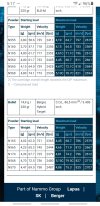I think you both are saying similar things. Let me summarize it this way. This may be over simplified.
Each powder has it's own characteristics that determine bullet velocity such as energy content, density, and burn rate. Bullet weight, barrel length, primers, outside temp, cartridge efficiency, barrel manufacturer, seating depth, neck tension, etc. are among other factors that can affect the powder and bullet speed. It is the combination of all factors is what will determine bullet velocity, not just where it sits on the burn rate chart.
N568 has lower energy content - yes you'd need more of it than you would of N570
N568 is less dense - again you'd need more of it - grains measured by weight not by volume in the case
N568 has a faster burn rate. Although its burn rate is faster, it will still have slower bullet velocity due to density and energy content being less than N570
N570 has a slower burn rate and with heavies produces the faster bullet velocity. Probably not going to be great for ultra light bullets or small calibers or shorter barrels.

